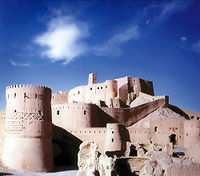Bam, Iran
Economically and commercially, Bam occupied a very important place in the region and was famous for its textiles and clothes.
Ibn Hawqal (943–977), an Arab traveller and geographer, wrote of Bam in his book Surat-ul-'Ard (The Earth-figure): The ancient citadel of Arg-e Bam has a history dating to around 2,000 years ago, to the Parthian Empire (248 BC–224 AD), but most buildings were built during the Safavid dynasty.
Subsequently, after the city had gradually been re-settled, it was abandoned a second time due to an attack by invaders from Shiraz.
The modern city of Bam has gradually developed as an agricultural and industrial centre, and until the 2003 earthquake was experiencing rapid growth.
[7] The city also benefited from tourism, with an increasing number of people visiting the ancient citadel in recent years.
The effects of the earthquake and damage was exacerbated by the fact that the city chiefly consisted of mud brick buildings, many of which did not comply with earthquake regulations set in Iran in 1989, and that most of the city's people were indoors and asleep at the time the main tremor struck.
Following the earthquake the U.S. offered direct humanitarian assistance to Iran and in return the state promised to comply with an agreement with the International Atomic Energy Agency which supports greater monitoring of its nuclear interests.
On 16 March 2007 a 130 km/h (81 mph) sandstorm hit the city of Bam without warning, suffocating three children, killing two in car accidents, and injuring 14 others.


